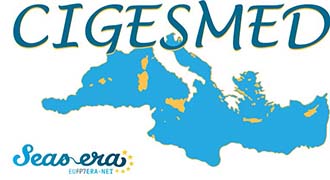There is no real consensus among scientists studying benthic communities in the Mediterranean Sea about what a coralligenous habitat is.
“…The main criterion used to define the coralligenous habitat is the presence of a bioherm of coralline algae grown at low irradiance levels and in relatively calm waters. This bioherm is always very complex in structure and, in fact, allows the development of several kinds of communities (Laborel 1961, Laubier 1966), including those dominated by living algae (upper part of the concretions), suspension feeders (lower part of the concretions, wall cavities and overhangs), borers (inside the concretions) and even soft-bottom fauna (in the sediment deposited in cavities and holes). Therefore, the coralligenous habitat should be considered more as a sub-marine landscape or community puzzle rather than a single community. …” Enric Ballesteros, 2006
The Mediterranean owes much of its exceptional species richness to two coastal habitats, the most typical of this sea, the Posidonia meadow and the coralligenous.
While seagrass beds are easily identifiable and recognised by both specialists and the general public, the term coralligenous projects a much more ambiguous image. In fact, because it is deeper and therefore less accessible, and because it is polymorphous, except for the specialist, it does not directly evoke a specific habitat or set of habitats. However, its extraordinary richness in species favoured by a great structural complexity due to a double activity of bio-construction (by red calcareous algae, bryozoans, sponges) and erosion (due to sponges and perforating molluscs, echinoderms, mushrooms) as well as a spectacular associated fauna (large gorgonians, sponges) make it one of the most beautiful landscapes in the Mediterranean, very varied locally and geographically, and over a vast range of depths. It is not uncommon for a diver to (re)know the coralligenous, without knowing how to name it.
The term “coralligenous”, originally “coralligenous gravel“, was created (1883) by Antoine-Fortuné Marion, founder of the Endoume Marine Station, to define more scientifically the hard bottoms between 30 and 70 m, between the Posidonia meadows and the muddy bottoms, where the Marseilles fishermen worked, the broundo. He chose a term that means “coral producer” in reference to the abundance of red coral found there. But this environment was no more described than defined. It is in fact a concept that has developed thanks to diving, the most efficient scientific investigation technique compared to dredges and trawls, to study a hard, uneven bottom, with cavities, vertical sections and overhangs, and for which a bionomic framework has gradually been defined.
The coralligenous can have very diverse aspects, over more or less large areas and be more or less spectacular. Two main types of coralligenous populations can be distinguished, with all the possible intermediaries:
- The wall coralligenous: well developed on the drop-offs. Calcified algae are present but do not generate large constructions. The coverage of the walls is mainly by other sciaphilous algae and especially by invertebrates (sponges, cnidarians, bryozoans, etc.).
- Coralligenous bioconcretion: metric-sized buildings (bioherms) develop on the shallow bottom. The main structure is built by calcified coralline algae (Lithophyllum, Mesophyllum) and secondarily by other less calcified algae (Peyssonnelia, Halimeda) and fixed invertebrates with mineralised skeletons (scleractinian corals, serpulids, bivalves, bryozoans). These biogenic constructions are one of the great originalities of the Mediterranean.
The physiognomy of the landscapes they create is marked by erect organisms, often of great size: gorgonians (Paramuricea, Eunicella, …), sponges (Axinella, Spongia, …), bryozoans (Myriapora, …). A very diverse fauna is established in micro-habitats sheltered from light and current: cracks, anfractuosities, cavities dug by drilling organisms, overhangs. These mini- and micro-caves form a very dense network in the coralligenous bioconcretion. According to the latest estimates, nearly 1700 species are involved in the coralligenous.
This biodiversity and complexity are the source of ecosystem services of supply (fish, crustaceans, molluscs, red coral [jewellery]), culture (diving sites, recreational fishing, underwater hunting, support for research and potential discoveries [substances of therapeutic or industrial interest], source of inspiration), regulation (CO2 sequestration, bioindicators), and support (habitats and refuges, maintenance of diversity). The economic value of the coralligenous due to its fishing and landscape wealth explains why the coralligenous is considered a jewel of the Mediterranean’s underwater heritage, but it is fragile and its dynamics are very modest (very slow growth of most species). Its resilience is low and the sources of degradation multiple:
Destructive effects of contaminants on typical organisms structuring the coralligenous (Lithophyllum, gorgonians, large branching bryozoans) which spare tolerant species that will proliferate (Cliona perforating sponges and other borers) and erode it.
- Effects of anchors and fishing gear
- Effects of divers and underwater hunters
- Effects of invasive species (Caulerpa, Womersleyella) which by covering the coralline algae prevent them from having access to the light necessary for efficient and sufficient photosynthesis
- Effects of heat waves causing excessive temperature rise and mass mortalities among gorgonians and some other species (sponges, molluscs, bryozoans), destroying habitats and landscapes.
- Effects of recreational and professional fishing, which ultimately degrade the biodiversity of the coralligenous.
All this represents ecological and societal issues that are the subject of studies on a pan-Mediterranean scale (UNEP CAR/ASP programme http://www.rac-spa.org/fr/coralligene, SeasEra CIGESMED project www.cigesmed.eu), or locally and regionally (Mediterranean coastal OHM, EvaCor, CEMOCoast projects). The aesthetic value of coralligenous landscapes has been the subject of a particular study (Tribot, A.-S. et al. Taxonomic and functional diversity increase the aesthetic value of coralligenous reefs. Sci. Rep. 6, 34229; doi: 10.1038/srep34229 (2016)Taxonomic and functional diversity increase the aesthetic value of coralligenous reefs.
